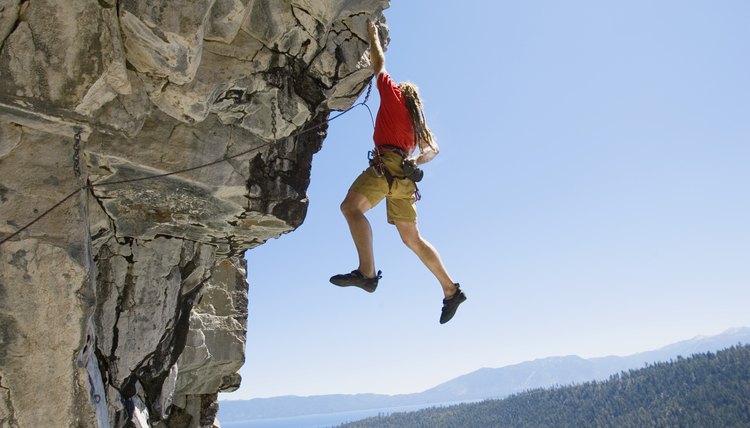What does fact checked mean?
At SportsRec, we strive to deliver objective content that is accurate and up-to-date. Our team periodically reviews articles in order to ensure content quality. The sources cited below consist of evidence from peer-reviewed journals, prominent medical organizations, academic associations, and government data.
The information contained on this site is for informational purposes only, and should not be used as a substitute for the advice of a professional health care provider. Please check with the appropriate physician regarding health questions and concerns. Although we strive to deliver accurate and up-to-date information, no guarantee to that effect is made.
How to Get Better at Crimp Climbing

Rock climbing helps improve your cardiovascular system and strengthen your muscles. Crimping is a climbing hold on a small but a positive edge that can fit only the tips of your fingers. According to the Rock Climbing for Life website, crimping is the most stressful way to grip a rock. It involves hyper extension of the first joint in your fingers and full contraction of the second joint. Improve your crimp climbing by improving the strength of your hands, arms, back and core muscles.
Do weighted hand exercises using a grip board. Strong hands are required to execute the crimp hold. Start with your body weight and hang from a grip at least 10 seconds. Once you can hold on for 10 seconds, use a weighted belt or a heavy backpack to add resistance. Start with a larger grips and move to smaller holds as your strength improves.
Strengthen the muscles in your arms and back that are required for bending and locking your arms in a crimp hold. Do exercises that strengthen your biceps, triceps, latissimus dorsi and pectorals. Useful exercises are chin-ups or pullups that you can do using a few different techniques. Pull your self up and hold for seven seconds, lower and repeat. Do a chinup and lower yourself until your arms form a 90- or 130-degree angle, hold for seven seconds, lower and repeat. Try to do eight repetitions. If you cannot, use a chair to take of some of your weight. Once you get stronger, remove the chair and begin to add weights. You also can do traditional weight training moves, such as curls, pull-downs and bench presses.
Improve core muscles that are needed to balance and stabilize your torso, feet and hips. Focus on strengthening the muscles in your abdomen, lower back and thighs. Do leg lifts by hanging from good climbing holds or a pullup bar. Lift your legs up by bending your waist. Start by keeping your knees bent, and, as your muscles get stronger, straighten your legs in front of you. Lift up, hold for few seconds and slowly lower the legs straight. Another effective move to strengthen your core is the "Superman." Start by lying on the floor face-down, with your hands and knees straight. Raise an opposite arm and leg to a horizontal position, hold for few seconds and lower. You also can do the move by raising both of your hands and legs at the same time.
Tape your fingers to support your joints. Use around 1/4-inch wide sections of climbing tape to tape your fingers between the first and second joint and second and third joint. This helps support your joints and prevent injury that can be associated with crimping. Over time, as your muscles strengthen, you should not need the tape anymore.
Tips
Practice your technique on indoor climbing walls before setting out to climb real rocks.
Warnings
Do not do climbs with crimp holds until you have warmed your hands and fingers properly. Crimping can lead to injury of your fingers, especially if done without proper warm-up.
References
Writer Bio
Maria Hoven is a health and fitness expert with over 10 years of expertise in medical research. She began writing professionally in 2004 and has written for several websites including Wound Care Centers and healthnews.org. Hoven is earning a Doctor of Philosophy in cell and molecular biology from the University of Nevada, Reno.
